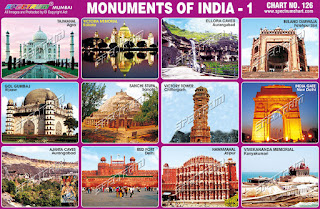 |
| Monuments of India Chart |
Spectrum Chart - 126 : Monuments of India 1
- Taj Mahal (Agra) – Taj Mahal is known as a symbol of love. Taj Mahal was built by the Mughal Emperor Shah Jahan in the memory of his wife Mumtaz Mahal. Construction of Taj Mahal took 22 years & was completed in 1653.
- Victoria Memorial (Kolkata) - Victoria Memorial is a large marble building in Kolkata which was built between 1906 and 1921. It is dedicated to the memory of Queen Victoria and is now a museum and tourist destination.
- Ellora Caves (Aurangabad) – Ellora Caves are an UNESCO World Heritage Site and forms one of major tourist attraction in Marathwada region of Maharashtra. Ellora is known for Hindu, Buddhist and Jain cave temples built during (6th and 9th centuries) the rule of the Kalachuri, Chalukya and Rashtrakuta dynasties.
- Buland Darwaja (Fatehpur Sikri) - Buland Darwaza or the "Gate of Magnificence", was built in 1576 A.D. by Mughal Emperor Akbar to commemorate his victory over Gujarat. It is the main entrance to the palace at Fatehpur Sikri.
- Gol Gumbaj (Bijapur) - Gol Gumbaz is the mausoleum of Mohammed Adil Shah, Sultan of Bijapur. The tomb, located in Bijapur, Karnataka in India, was completed in 1656. It is constructed as per the Deccan architecture.
- Sanchi Stupa (Sanchi) - The Great Stupa at Sanchi is the oldest stone structure in India and was originally commissioned by the emperor Ashoka the Great in the 3rd century BCE.
- Victory Tower (Chittorgarh) - Vijay Stambha/Victory Tower is an imposing victory monument located in Chittorgarh fort in Chittorgarh. It was constructed by Mewar King Rana Kumbhain 1448 to commemorate his victory over the combined armies of Malwa and Gujarat led by Mahmud Khilji.
- India Gate (New Delhi) - India Gate is a war memorial located astride the Rajpath in New Delhi. India gate is a memorial to 82,000 soldiers of the undivided Indian Army who died in the period 1914–21 in the First World War. In 1971, following the Bangladesh Liberation war. Structure called Amar Jawan Jyoti, has served as India’s Tomb of the Unknown Soldier.
- Ajanta Caves (Aurangabad) - Ajanta Caves in Aurangabad are about 30 rock-cut Buddhist cave monuments which date from the 2nd century BCE to about 480 or 650 CE. The caves include paintings and sculptures described by the government Archaeological Survey of India as "the finest surviving examples of Indian art".
- Red Fort (Delhi) - Red Fort was the residence of the Mughal emperor of India for nearly 200 years, until 1857. It is located in the centre of Delhi and houses a number of museums. Constructed in 1648 by the fifth Mughal Emperor Shah Jahan as the palace of his fortified capital Shahjahanabad, the Red Fort is named for its massive enclosing walls of red sandstone.
- Hawa Mahal (Jaipur) - Hawa Mahal is a palace in Jaipur, so named because it was essentially a high screen wall built so the women of the royal household could observe street festivals while unseen from the outside. The structure was built in 1799 by Maharaja Sawai Pratap Singh.
- Vivekananda Memorial (Kanyakumari) - Vivekananda Memorial is a popular tourist monument in Kanyakumari, India. The memorial stands on one of two rocks located about 500 meters east off mainland of Vavathurai, India's southernmost tip. It was built in 1970 in honour of Swami Vivekananda who is said to have attained enlightenment on the rock.

No comments:
Post a Comment